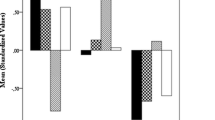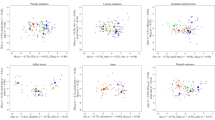Abstract
Four experiments were conducted to investigate the interplay between context and tone of voice in the perception of sarcasm. These experiments emphasized the role of contrast effects in sarcasm perception exclusively by means of auditory stimuli whereas most past research has relied on written material. In all experiments, a positive or negative computer-generated context spoken in a flat emotional tone was followed by a literally positive statement spoken in a sincere or sarcastic tone of voice. Participants indicated for each statement whether the intonation was sincere or sarcastic. In Experiment 1, a congruent context/tone of voice pairing (negative/sarcastic, positive/sincere) produced fast response times and proportions of sarcastic responses in the direction predicted by the tone of voice. Incongruent pairings produced mid-range proportions and slower response times. Experiment 2 introduced ambiguous contexts to determine whether a lower context/statements contrast would affect the proportion of sarcastic responses and response time. Results showed the expected findings for proportions (values between those obtained for congruent and incongruent pairings in the direction predicted by the tone of voice). However, response time failed to produce the predicted pattern, suggesting potential issues with the choice of stimuli. Experiments 3 and 4 extended the results of Experiments 1 and 2, respectively, to auditory stimuli based on written vignettes used in neuropsychological assessment. Results were exactly as predicted by contrast effects in both experiments. Taken together, the findings suggest that both context and tone influence how sarcasm is perceived while supporting the importance of contrast effects in sarcasm perception.
Similar content being viewed by others
Notes
Considering that the dependent variable was a proportion, these data were also analyzed with logit mixed modeling, as recommended by Jaeger (2008). When analyzed in this manner, the results remained exactly the same in all experiments. Accordingly, only analysis of variance results are reported as this approach is likely more familiar to all readers. In addition, analysis of variance greatly facilitates the examination of the pattern of differences among means crucial to the hypotheses.
References
Anoli, L., Ciceri, R., & Infantino, M. G. (2002). From “blame to praise” to “praise to blame”: Analysis of vocal patterns in ironic communication. International Journal of Psychology, 37, 266–276. doi:10.1080/00207590244000106.
Attardo, S. (2000). Irony markers and functions: Towards a goal-oriented theory of irony and its processing. Rask, 12, 3–20.
Boylan, J., & Katz, A. N. (2013). Ironic expression can simultaneously enhance and dilute perception of criticism. Discourse Processes, 50, 187–209. doi:10.1080/0163853X.2012.747041.
Bryant, G. A., & Fox Tree, J. E. (2005). Is there an ironic tone of voice? Language and Speech, 48, 257–277. doi:10.1177/00238309050480030101.
Bryant, G. A., & Fox Tree, J. E. (2002). Recognizing verbal irony in spontaneous speech. Metaphor and Symbol, 17, 99–117. doi:10.1207/S15327868MS1702_2.
Burgers, C., van Mulken, M., & Schellens, P. J. (2011). Finding irony: An introduction of the verbal irony procedure (VIP). Metaphor and Symbol, 26, 186–205. doi:10.1080/10926488.2011.583194.
Burgers, C., van Mulken, M., & Schellens, P. J. (2011). Type of evaluation and marking of irony: The role of perceived complexity and comprehension. Journal of Pragmatics, 44, 231–242. doi:10.1016/j.pragma.2011.11.003.
Channon, S., Pellijeff, A., & Rule, A. (2005). Social cognition after head injury: Sarcasm and theory of mind. Brain and Language, 93, 123–134. doi:10.1016/j.bandl.2004.09.002.
Cheang, H. S., & Pell, M. D. (2008). The sound of sarcasm. Speech Communication, 50, 366–381. doi:10.1016/j.specom.2007.11.003.
Colston, H. L. (2002). Contrast and assimilation in verbal irony. Journal of Pragmatics, 34, 111–142. doi:10.1016/S0378-2166(02)80008-X.
Colston, H. L., & O’Brien, J. (2000a). Contrast and pragmatics in figurative language: Anything understatement can do, irony can do better. Journal of Pragmatics, 32, 1557–1583. doi:10.1016/S0378-2166(99)00110-1.
Colston, H. L., & O’Brien, J. (2000b). Contrast of kind vs. contrast of magnitude: The pragmatic accomplishments of irony and hyperbole. Discourse Processes, 30, 179–199. doi:10.1207/S15326950DP3002_05.
Capelli, C. A., Nakagawa, N., & Madden, C. M. (1990). How children understand sarcasm: The role of context and intonation. Child Development, 61, 1824–1841. doi:10.1111/j.1467-8624.1990.tb03568.x.
Gardner, H., & Brownell, H. H. (1986). The right hemispheric communication battery. Boston: Psychology Service.
Gerrig, R. J., & Goldvarg, Y. (2000). Additive effects in the perception of sarcasm: Situational disparity and echoic mention. Metaphor and Symbol, 15, 197–208. doi:10.1207/S15327868MS1504_1.
Gibbs, R. W, Jr. (2000). Irony in talk among friends. Metaphor and Symbol, 15, 5–27. doi:10.1080/10926488.2000.9678862.
Gibbs, R. W. (1994). Figurative thought and figurative language. In M. A. Gernsbacher (Ed.), Handbook of psycholinguistics (pp. 411–446). New York, NY: Academic.
Gibbs, R. W., & Colston, H. L. (2002). The risks and rewards of ironic communication. In L. Anolli, R. Ciceri, & G. Riva (Eds.), Say not to say: New perspectives on miscommunication (pp. 181–194). Washington, DC: IOS Press.
Giora, R. (1997). Understanding figurative and literal language: The graded salience hypothesis. Cognitive Linguistics, 7, 183–206. doi:10.1515/cogl.1997.8.3.183.
Giora, R., Zaidel, E., Soroker, N., Batori, G., & Kasher, A. (2000). Differential effects of right- and left-hemisphere damage on understanding sarcasm and metaphor. Metaphor and Symbol, 15, 63–83. doi:10.1080/10926488.2000.9678865.
Happé, F. G. E. (1994). An advanced test of theory of mind: Understanding of story characters’ thoughts and feelings by able autistic, mentally handicapped, and normal children and adults. Journal of Autism and Developmental Disorders, 24, 129–154. doi:10.1007/BF02172093.
Ivanko, S. L., & Pexman, P. M. (2003). Context incongruity and irony processing. Discourse Processes, 35, 241–279. doi:10.1207/S15326950DP3503_2.
Jaeger, T. F. (2008). Categorical data analysis: Away from ANOVAs (transformation or not) and towards logit mixed models. Journal of Memory and Language, 59, 434–446. doi:10.1016/j.jml.2007.11.007.
Katz, A. N. (2005). Discourse and sociocultural factors in understanding nonliteral language. In H. Colston & A. N. Katz (Eds.), Figurative language comprehension: Social and cultural influences (pp. 183–207). Mahwah, NJ: Erlbaum.
Kreuz, R., & Glucksberg, S. (1989). How to be sarcastic: The echoic reminder theory of verbal irony. Journal of Experimental Psychology: General, 118, 374–386. doi:10.1037/0096-3445.118.4.374.
Kreuz, R. J., & Link, K. E. (2002). Asymmetries in the use of verbal irony. Journal of Language & Social Psychology, 21, 127–143. doi:10.1177/02627X02021002002.
Kreuz, R. J., & Roberts, R. M. (1995). Two cues for verbal irony: Hyperbole and the ironic tone of voice. Metaphor and Symbolic Activity, 10, 21–31. doi:10.1207/s15327868ms1001_3.
Kumon-Nakamura, S., Glucksberg, S., & Brown, M. (1995). How about another piece of pie: The allusional pretense theory of discourse irony. Journal of Experimental Psychology: General, 124, 3–21. doi:10.1037/0096-3445.124.1.3.
Milosky, L. M., & Ford, J. A. (1997). The role of prosody in children’s inferences of ironic intent. Discourse Processes, 23, 47–61. doi:10.1080/01638539709544981.
Nakassis, C., & Snedeker, J. (2002). Beyond sarcasm: Intonation and context as relational cues in children’s recognition of irony. Retrieved from https://software.rc.fas.harvard.edu/lds/wp-content/uploads/2012/04/Nakassis_Snedeker_2002.pdf, on July 26, 2013.
Nittrouer, S., Studdert-Kennedy, M., & McGowan, R. S. (1989). The emergence of phonetic segments: Evidence from the spectral structure of fricative-vowel syllables spoken by children and adults. Journal of Speech and Hearing Research, 32, 120–132.
Persicke, A., Tarbox, J., Ranick, J., & St. Clair, M. (2013). Teaching children with autism to detect and respond to sarcasm. Research in Autism Spectrum Disorders, 7, 193–198. doi:10.1016/j.rasd.2012.08.005.
Pexman, P. M., Whalen, J. M., & Green, J. (2010). Understanding verbal irony: Clues from interpretation of direct and indirect remarks. Discourse Processes, 47, 237–261. doi:10.1080/01638530902959901.
Ratcliff, R. (1993). Methods for dealing with reaction time outliers. Psychological Bulletin, 114, 510–532. doi:10.1037/0033-2909.114.3.510.
Rockwell, P. M. (2007). Vocal features of conversational sarcasm: A comparison of methods. Journal of Psycholinguistic Research, 36, 361–369. doi:10.1007/s10936-006-9049-0.
Rockwell, P. (2000). Lower, slower, louder: Vocal cues of sarcasm. Journal of Psycholinguistic Research, 29, 483–495. doi: 10.1023/A:1005120109296.
Sabbagh, M. A. (1999). Communicative intentions and language: Evidence from right-hemisphere damage and autism. Brain and Language, 70, 29–69. doi:10.1006/brln.1999.2139.
Schneider, w, Eschman, A., & Zuccolotto, A. (2002). E-prime user’s guide: Version 1.0. Pittsburgh, PA: Psychology Software Tools.
Schneider, W., Eschman, A., & Zuccolotto, A. (2002). E-prime user’s guide: Version 1.0. Pittsburgh, PA: Psychology Software Tools Inc.
Utsumi, A. (2000). Verbal irony as implicit display of ironic environment: Distinguishing ironic utterances from nonirony. Journal of Pragmatics, 32, 1777–1806. doi:10.1016/S0378-2166(99)00116-2.
Vannier, S. A., & Voyer, D. (2012). Sarcasm perception and quality of per and romantic relationships. Canadian Psychology, 53(2a), 176.
Vermeulen, P. (2014). Context blindness in autism spectrum disorder: Not using the forest to see the trees as trees. Focus on autism and other developmental disabilities. 11. doi:10.1177/1088357614528799.
Voyer, D., Bowes, A., & Techentin, C. (2008). On the perception of sarcasm in dichotic listening. Neuropsychology, 22, 390–399. doi:10.1037/0894-4105.22.3.390.
Voyer, D., & Techentin, C. (2010). Subjective acoustic features of sarcasm. Metaphor and Symbol, 25, 1–16. doi:10.1080/10926488.2010.510927.
Walter, H., Adenzato, M., Ciaramidaro, A., Enrici, I., Pia, L., & Bara, B. G. (2007). Understanding intentions in social interaction: The role of the anterior paracingulate cortex. Journal of Cognitive Neuroscience, 16, 1854–1863. doi:10.1162/0898929042947838.
Woodland, J., & Voyer, D. (2011). Context and intonation in the perception of sarcasm. Metaphor and Symbol, 26, 227–239. doi:10.1080/10926488.2011.583197.
Author information
Authors and Affiliations
Corresponding author
Additional information
The study reported here was supported by a grant from the Natural Sciences and Engineering Research Council of Canada to D. Voyer. The authors thank Kyle J. Brymer and Jennifer A. Harding for their assistance with data collection and scoring. In addition the authors are grateful to Cheryl L. Techentin and Susan D. Voyer for their contribution to stimulus production.
Rights and permissions
About this article
Cite this article
Voyer, D., Thibodeau, SH. & Delong, B.J. Context, Contrast, and Tone of Voice in Auditory Sarcasm Perception. J Psycholinguist Res 45, 29–53 (2016). https://doi.org/10.1007/s10936-014-9323-5
Published:
Issue Date:
DOI: https://doi.org/10.1007/s10936-014-9323-5




